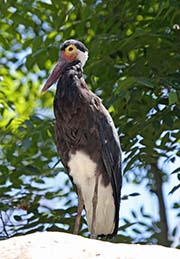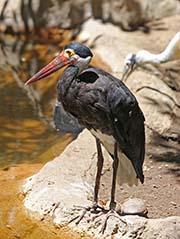Storm's Stork - Ciconia stormi
| Length | |
| Wingspan | |
| Clutch Size | |
| Chicks at birth | |
| IUCN Conservation Status | |
Continents: |
The Storm's Stork is found in Malaysia and Indonesia. It is usually a solitary bird but will occasionally be found in small groups. The body is black and white and the bill is red with some orange facial skin. Yellow skin surrounds the dark eyes. The legs and feet are red. Both sexes are similar. Juveniles have more brown than black plumage, a dark tipped bill and the bare skin is a duller color.
The Storm's Stork is classified as Endangered and is on the IUCN Red List of Threatened Species. It is believed that there are less than 500 individuals left. Mostly the decline has been due to small initial numbers over a limited range and loss of habitat. Overhunting has also contributed to the decline. Efforts are underway in Thailand, Malaysia and Indonesia to protect them.
Diet: Storm's Storks mainly consume fish.
Courtship: The courtship rituals for Storm's Stork has not been well studied but it is believed that part of the courtship ritual includes aerial displays. The pair bond can last for many years.
Nesting: Nests are reused year-to-year. The female usually lays two eggs in stick platform nest high at the top of a tree. They may overhang water. The chicks are altricial at birth and need complete care, but they grow fast.
Habitat and Range: Storm's Storks live in small groups or alone. They prefer undisturbed lowland forests near freshwater or the floodplains of large rivers. They are found in Indonesia, Malaysia, and Thailand.
Vocalization: Storks don't have a pharynx so the sounds they make are produced by the clacking of their bills.
Plumage/Molt Storm's Stork do not have an alternate or breeding plumage so they probably molt annually.
Migration: Don't believe Storm's Storks migrate.
Tongue/feet: Legs and feet are red.
Bibliography:
- http://en.wikipedia.org The Free Encyclopedia, Accessed July, 2012
- http://birdlife.org BirdLife International, Accessed July, 2012
- http://www.sandiegozoo.org/animalbytes/ San Diego Zoo, Accessed July, 2012




